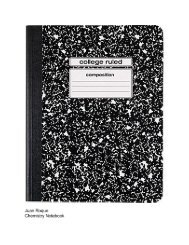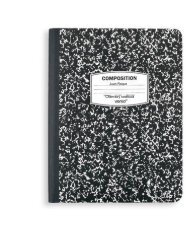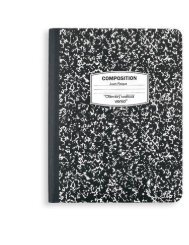You also want an ePaper? Increase the reach of your titles
YUMPU automatically turns print PDFs into web optimized ePapers that Google loves.
methane and compounds found in oil, grease and gasoline don’t dissolve in water but in gasoline. When<br />
an ionic solid dissolves, the ions become solvated or surrounded by solvent molecules. Water molecules<br />
are in continuous motion because they have kinetic energy. Some ionic compounds, the attractions<br />
among the ions in the crystals are stronger than the attractions exerted by water. These compounds<br />
cannot be solvated to any significant extent and are therefore nearly insoluble. Oil and gasoline do not mix<br />
with water because they are composed of nonpolar molecules. The attractive forces that hold two<br />
molecules in oil together are similar in magnitude to the forces that hold two molecules in gasoline<br />
together. Molecules in oil can easily separate and replace molecules in gasoline to form a solution. Polar<br />
solvents dissolve ionic compounds and nonpolar compounds - like dissolves like.<br />
Electrolytes and Nonelectrolytes<br />
All ionic compounds are electrolytes because they dissociate into ions.<br />
Electrolyte: A compound that conducts an electric current when it is in an aqueous solution or in the molten<br />
state. Nonelectrolyte: A compound that conduct an electric current in either an aqueous solution or the molten<br />
state. Strong electrolyte: . Weak electrolyte: Conducts an electric current poorly because only a fraction of the<br />
solute in the solution exists as ions.<br />
Conduction of an electric current requires ions that are mobile and thus able to carry changes through a liquid.<br />
The solution conducts an electric current if it contains ions. Some polar molecular compounds are<br />
nonelectrolytes in the pure state but become electrolytes when they dissolve in water. This change occurs<br />
because such compounds ionize in solutions. Not all electrolytes conduct an electric current to the same<br />
degree. In a solution that contains a strong electrolyte all or nearly all of the solute exists as ions. The ions<br />
move in solution and conduct an electric current. Inorganic bases and acids are strong electrolytes. Organic<br />
acid and bases are weak electrolytes. Electrolytes are essential to metabolic processes as it carries electrical<br />
impulses internally and to other cells. However, an electrolyte imbalance can occur if you become dehydrated.<br />
Hydrates<br />
The forces holding the water molecules in hydrates are not very strong, so the water is easily lost and<br />
regained.<br />
Water of hydration: Water contained in a crystal. Hydrate: A compound that contains water of hydration.<br />
Effloresce: . Anhydrous: A substance that does not contain water. Hygroscopic: Hydrates or other<br />
compounds that remove moisture from air. Desiccant: Substance sued to absorb moisture from air and<br />
create dry atmosphere. Deliquescent: They remove sufficient water from the air to dissolve completely<br />
and form solutions.<br />
Water can be driven from a hydrate from heating it. Water molecules are an integral part of the crystal<br />
structures. In writing the formula of a hydrate, use a dot to connect the formula of the compound and the<br />
number of water molecules per formula unit. The water molecules in hydrates are held by weak forces so<br />
hydrates often have vapor pressure. As the crystals lose water of hydration, they effloresce and become<br />
coated with a white powder of anhydrous sodium carbonate. Hydrated ionic compounds that have a low<br />
vapor pressure remove water from moist air to form higher hydrates. A desiccator may contain calcium<br />
chloride. Substance that must be kept dry are stored inside.<br />
15.3 Heterogeneous Aqueous Systems<br />
Suspensions<br />
A suspension differs from a solution because the particles of a suspension are much larger and do not<br />
stay suspended indefinitely.<br />
Suspension: A mixture from which particles settle out upon standing<br />
Suspension are heterogeneous because at least two substances can be identified.<br />
Colloids<br />
Colloids have particles smaller than those in suspensions and larger than those in solutions.<br />
Colloids: A heterogeneous mixture containing particles that range in size from 1 n to 1000 nm. Typical<br />
effect: the scattering of visible light by colloidal particles. Brownian motion: Chaotic movement of colloidal<br />
particles. Emulsion: A colloidal dispersion of a liquid in a liquid.<br />
Particles are spread or dispersed. They’re cloudy so they can be distinguished by Tyndall effect and by<br />
the observation of Brownian motion. They are also subject to coagulation or clumping together and they<br />
can be emulsified or made stable. Coagulation are when they absorb ions from the from the dispersing<br />
medium onto the surface.<br />
Page 125






